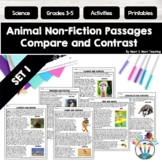68 results
Higher education astronomy laboratories
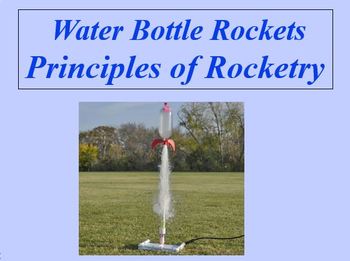
Water Bottle Rocket Launch Bundle
Want your students to study and launch water bottle rockets but need guidance? Well, I am here to help. The PowerPoint in this bundle will take your students through key vocabulary such as drag, ballast, thrust and discuss how Newton’s Three Laws affect the launch of a rocket. Day 1, students will work through the PowerPoint individually and design a water bottle rocket. Students will then join with a partner who also has a plan and merge their ideas into one design plan that they will build.
Subjects:
Grades:
5th - 12th, Higher Education
Types:
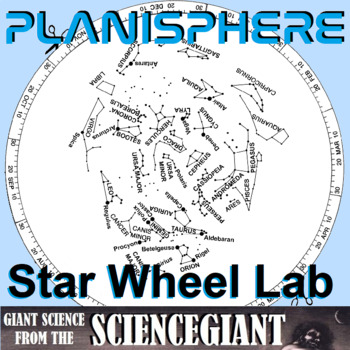
Planisphere Lab Activity: A Star Wheel for Constellation Exploration
Inexpensive and ingenious! Planispheres are a unique tool for learning astronomy: a make-it-yourself star map, adjustable for any time of night in any month of the year. They are designed to show the position of prominent constellations in the night sky. It's a low-tech way for Ss to learn the location (and thus give meaning to key vocabulary terms) of the horizon, zenith, meridian, ecliptic and celestial equator on the celestial sphere. This lab includes two types of planispheres: one for stan
Subjects:
Grades:
6th - 12th, Higher Education
Types:
NGSS:
HS-ESS1-4
, 5-ESS1-2
, MS-ESS1-1
Also included in: StayGiant Earth Science Bundle: Astronomy (space exploration)
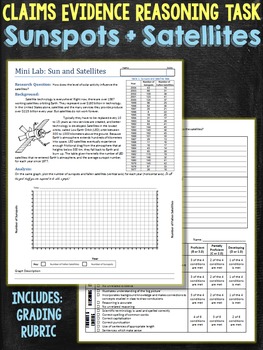
Lab Activity Effect of Sunspots on Satellites (Claims Evidence Reasoning Task)
A short lab activity for astronomy or earth space science. Students make a double line graph of the number of sunspots and the number of crashed satellites in a given year. Then they look for patterns and write a science conclusion utilizing claim, evidence, reasoning scaffolding framework.
Grading rubric and sample student responses are included
This lab activity blends well into a unit on electromagnetic waves, planetary mechanics, or the Sun's influence on Earth.
Subjects:
Grades:
7th - 12th, Higher Education
Types:
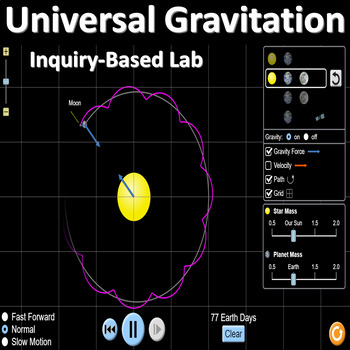
Universal Gravitation and Orbits Inquiry Lab (Phet Simulation) | Physics
This is a simple inquiry-based lab that I love to give students as an intro to Universal Gravitation. Students will figure out for themselves conceptual problems involving Universal Gravitation. They will get the basic idea of how Universal Gravitation works while discovering mind-blowing concepts, such as how the mass affects the gravitational pull on different objects. Lastly, the last page of the lab also includes calculations for students who have been introduced to the math portion of Unive
Subjects:
Grades:
7th - 12th, Higher Education
Types:
NGSS:
HS-PS2-1
, HS-PS2-4
Also included in: HIGH SCHOOL PHYSICS | Entire Year Lab Bundle | NGSS Curriculum
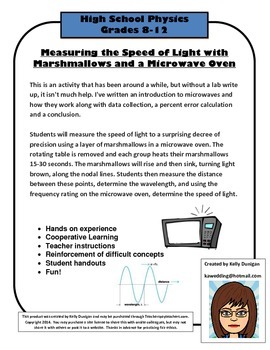
Measuring the Speed of Light: Marshmallows and Microwaves
This is an activity that has been around a while, but without a lab write up, it isn't much help. I've written an introduction to microwaves and how they work along with data collection, a percent error calculation and a conclusion.
Students will measure the speed of light to a surprising decree of precision using a layer of marshmallows in a microwave oven. The rotating table is removed and each group heats their marshmallows 15-30 seconds. The marshmallows will rise and then sink, turning
Subjects:
Grades:
7th - 12th, Higher Education
Types:
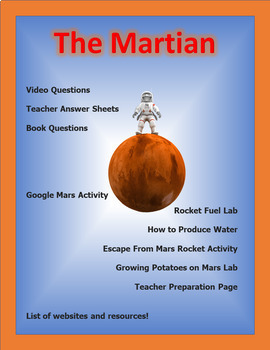
The Martian Classroom Labs and Activities
Product DescriptionThis is an multi sensual immersion into the world created in The Martian by Andy Weir. All are in Word format so that you can customize to your school's needs. The Martian Video Questions We have included both a blank Student Video Question worksheet and a Teacher Answer Sheet. Asks questions in order of the movies so that you can stop and discuss the various topics as the movie is viewed. Great intro to the concept of Mars colonization.The Martian Book QuestionsA chapter by
Subjects:
Grades:
6th - 12th, Higher Education
Types:
CCSS:
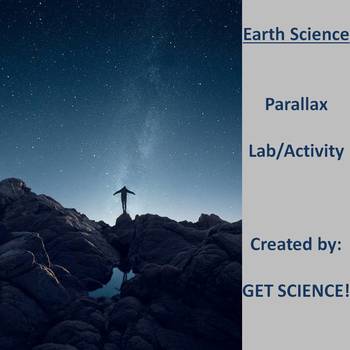
Understanding Parallax
This lab makes understanding parallax simple. Students use real world examples and draw so that parallax can be visualized. The concept is reinforced throughout. A summary YouTube video is included. My students completely understood the concept after this lab!You may edit this lab, the answer key is provided.Educating the World Together!Get Science
Subjects:
Grades:
8th - 12th, Higher Education
Types:
Also included in: Astronomy Lab Bundle
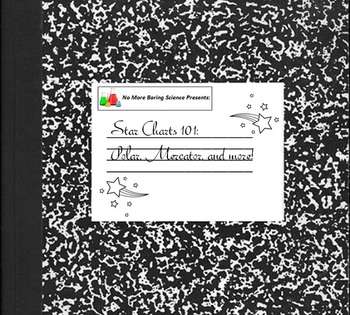
Astronomy/Earth Science Lab Series - Using Star Charts to find Constellations
New from No More Boring Science - How to use star charts! The focus of this lab is to help students gain confidence using star charts to find constellations. There are two activities in this lab: using a polar star chart map to find constellations on a blank section of the sky, and then translating constellations from a polar projection map to a mercator projection map. The first activity is more advanced than the second, but all maps and charts are included. Keys are included as well!
If you l
Subjects:
Grades:
7th - 12th, Higher Education, Adult Education
Types:
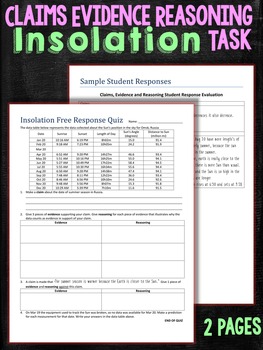
Claims Evidence Reasoning Task Insolation Seasons Quiz Assessment
Assessment task used to measure students ability to come up with a claim then support it with evidence and reasoning.
This task gives students data, and they use the data to come up with their claim, give evidence and reasoning. In addition students come up with evidence and reasoning against a given claim.
Topic: Seasons
Subject: Earth Space Science or Physical Science or Environmental
Standards Alignment: NGSS and Common Core Math and Literacy
Select a simple hypothesis, prediction, or concl
Subjects:
Grades:
6th - 12th, Higher Education
Types:
CCSS:

PhET Simulation Online Lab: Kepler's Laws
This PhET Kepler's Laws online physics lab will guide your students through an exploration of Kepler's three laws of planetary motion. First, they will learn about the characteristics of an ellipse. Next, by manipulating the variables and observing the real-time effects on planetary motion, students will investigate the elliptical orbits of planets and the relationship between orbital period, orbital speed, gravitational strength and the planet's distance from the sun. Students will collect and
Subjects:
Grades:
10th - 12th, Higher Education, Adult Education
Types:
Also included in: Growing Bundle: PhET Simulations Online Physics and Chemistry Labs
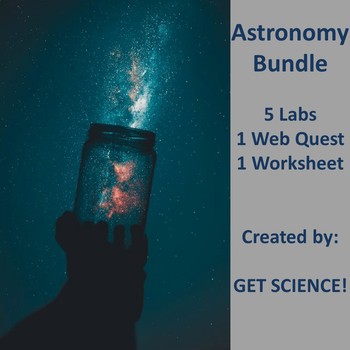
Astronomy Lab Bundle
This great Astronomy bundle contains 7 Labs, 1 Web Quest, 1 Introduction to Astronomy PowerPoint with the note sheet and a worksheet all listed below. A easy way to get all of your Astronomy needs!Labs:Eccentricity: Drawing EllipsesAtmospheres of Other WorldsH-R Diagram: Classifying StarsComparing the Sizes of the PlanetsThe Big BangUnderstanding the Parallax of StarsScale of the Solar SystemAlso included is a worksheet understanding Eccentricity that may be used before the Eccentricity lab a
Subjects:
Grades:
7th - 12th, Higher Education
Types:

Asteroid Impact Interactive(Simulation) Lab
In Part I of this Interactive/Simulation Lab, Students create their own asteroid by adjusting the variables (Velocity, Diameter, Composition, etc.) and then choose where they want their asteroid to Impact. After impact, the interactive will display the damage data.In Part II, students will design asteroids with Solar System objects as targets.An answer key is provided (although, answers will vary according to students choices). Word and PDF files included. An extra credit section available at
Subjects:
Grades:
6th - 12th, Higher Education, Adult Education
Types:

Mars Launch Lab - Kepler's Laws - Orbits Virtual Simulation Lab
Mars Launch Lab - Kepler's Laws - Orbits Virtual Simulation Lab consists of three parts. In Part I, Students follow a short (40 second) video with guided notes/questions. After the quick video, students play a game-like simulation where they need to find the correct date to minimize the time to get to Mars.In Part II, students use another simulation and adjust the orbital radius of a satellite to see the changes in Kinetic energy, orbital velocity, and time.In Part III, students use a third s
Subjects:
Grades:
7th - 12th, Higher Education, Adult Education
Types:
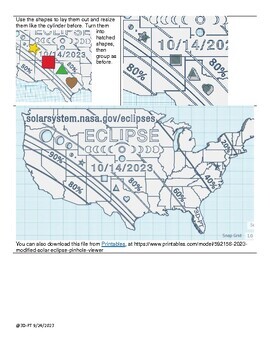
Shape the Eclipse Lab: Craft Your Pinhole Viewer with TinkerCAD!
On Oct.24, 2024 their will be an annular solar eclipse that will be viewable over the continental US! NASA released a 3D printable pinhole viewer for the USA. But they also released an activity to see if the size and shape of the pinhole affects the shape of the eclipse! In just a few steps, students can design and create their pinhole viewers, making this lab the ideal hands-on activity to witness this celestial event safely.Key Highlights: Solar Eclipse Ready: Prepare for the solar eclipse and
Grades:
6th - 12th, Higher Education, Adult Education
Types:
CCSS:
NGSS:
HS-ESS1-6
, HS-ESS1-4
, HS-ESS1-1

Why You Can't See Stars in A City Interactive Virtual Simulation Activity Lab
This Interactive Virtual Activity (or Lab) uses three simulations. Students see how adding artificial light (Light Pollution) makes it difficult to see the night sky. The activity includes step by step instructions with visual snip cues, making it accessible for all kinds of learners. Besides answering questions throughout the activity, students aer asked to graph the data accumulated and draw conclusions. This activity would be a great addition to any astronomy mini-lesson. Included are .
Subjects:
Grades:
5th - 12th, Higher Education, Adult Education

The Doppler Shift
The students examine the Doppler Shift in the Universe, by coloring and labeling emission spectra from several galaxies and comparing them to a standard. They discover several Galaxies are moving away from the Earth, causing the "Red Shift", while one is moving towards the Earth, creating a "Blue Shift."It involves coloring, which most students love, and has straight forward questions regarding the Doppler Effect.Customer Tips: How to get TPT credit to use on future purchases:Go to your "My Purc
Subjects:
Grades:
8th - 12th, Higher Education, Adult Education
Types:
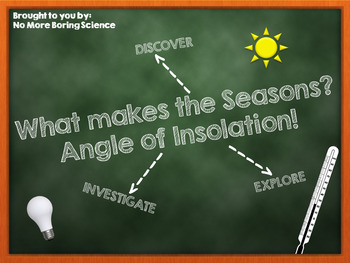
What makes the Seasons? Angle of Insolation!
The Earth's temperature is driven by angle of insolation. This is a fairly simply concept: the sun's light does not strike the surface at a right angle in most locations. Rather, it strikes it at an oblique angle, and it is this angle that causes different areas to experience different temperatures. This is a required topic for the New York Regents exam, and also in many earth science curricula. It is also a useful topic for astronomy classes, helping to explain climate mechanisms when modeling
Subjects:
Grades:
6th - 12th, Higher Education
Types:
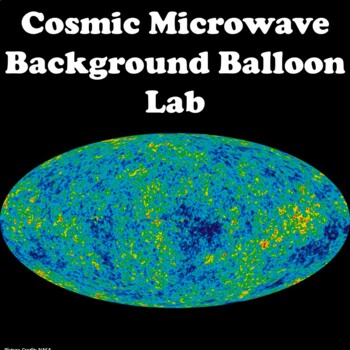
Cosmic Microwave Radiation Balloon Lab
Hands on modeling activity that allows students to measure and explain how cosmic background radiation stretched and transformed during the expansion on the universe.Teacher answer key included.Please click this link to follow me on TPT: Problems, Experiments, and SolutionsPlease leave a review of this product to earn TPT credit (5 cents of every dollar spent on a product you purchase and review that is applied to your next TPT purchase).
Subjects:
Grades:
6th - 12th, Higher Education
Types:

Parallax & Distance to the Stars - VIRTUAL LAB
In this lab students will conduct a hands-on lab in which they learn about parallax and how it is used to determine the distance to stars.The only equipment you need are a 30 cm ruler and Google Slides!A teacher guide with sample data and answers to post-lab questions is included!
Subjects:
Grades:
6th - 12th, Higher Education
Types:
NGSS:
MS-ESS1-2
, HS-ESS1-1
, MS-ESS1-1
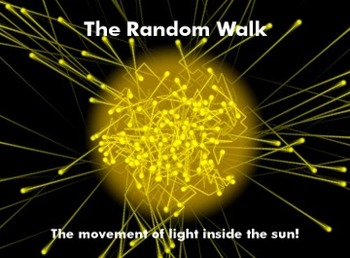
Astronomy/Earth Science Lab Activity - The Random Walk of Photons in a Star.
New from No More Boring Science - The core of the sun is a ball of superheated plasma that produces millions of watts of energy. Some of this energy is in the form of light. But, that light just doesn't stream to the surface, flying across space to shine down on us. No, things are more fascinating and complicated. It takes, on average, 16 million years for a photon of light to escape the sun and shine on us. Why? The Random Walk.
This lab helps model the random motion of photons of light as th
Subjects:
Grades:
7th - 12th, Higher Education, Adult Education
Types:
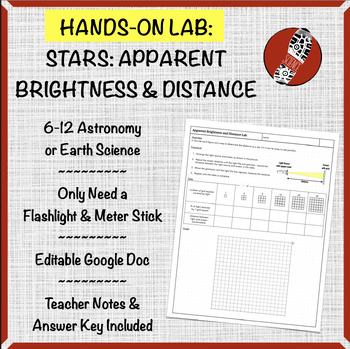
Stars: Apparent Brightness & Distances
Students will conduct a hands-on lab in which they discover the relationship between the Apparent Brightness of a Star and its Distance. Only equipment needed are a small light source (like a flashlight) and meter stick.Teacher guide with sample data and answers to post-lab questions are included!!
Subjects:
Grades:
6th - 12th, Higher Education
Types:
NGSS:
MS-ESS1-2
, HS-ESS1-1
, MS-ESS1-1
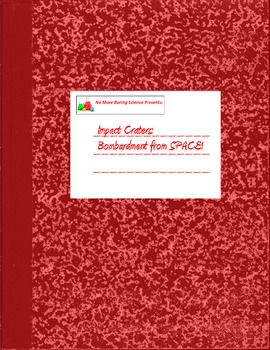
Astronomy/Earth Science Lab Activity - Impact Craters
New from No More Boring Science - Ever wondered how meteor craters are made? Trying to explain how the dinosaurs died? Wanting to find a cool way to engage your students with asteroids and comets? Look no further!
This lab activity is designed to show students not only how impact craters are made, but how the mass of the object affects the crater size. In addition, varying the acceleration of the object changes how the craters appear. Included extensions also quantify the activity, allowing thi
Subjects:
Grades:
7th - 12th, Higher Education, Adult Education
Types:

Parallax & Distance - Table Top Lab
In this lab students will conduct a hands-on lab in which they learn about parallax and how it is used to determine the distance to stars.The only equipment you need are a 30 cm ruler and a meter stick.A teacher guide with sample data and answers to post-lab questions is included!
Subjects:
Grades:
6th - 12th, Higher Education
Types:
NGSS:
MS-ESS1-2
, HS-ESS1-1
, MS-ESS1-1
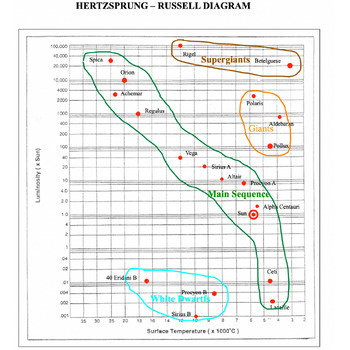
Plotting a HR Diagram
The students use a table of 20 Stars, that displays the Luminosity and Temperature of each star. The variables are plotted on a Hertzsprung - Russel template and show how stars may be grouped into The Main Sequence, Giants, Supergiants, and White Dwarfs. Several discussion questions help the students realize Stars may be grouped by these characteristics.It is a great introduction to the life cycle of stars and the nature of the universe.Customer Tips: How to get TPT credit to use on future purch
Subjects:
Grades:
6th - 12th, Higher Education, Adult Education
Types:
Showing 1-24 of 68 results




